
Bogotá from Monserrate. (874k)
From the Bogotá entry in Wikipedia:
Bogotá, officially Bogotá, Distrito Capital, abbreviated Bogotá, D.C., and formerly known as Santafé/Santa Fé de Bogotá between 1991 and 2000, is the capital and largest city of Colombia, administered as the Capital District, although often erroneously thought of as part of Cundinamarca. Bogotá is a territorial entity of the first order, with the same administrative status as the departments of Colombia. It is the political, economic, administrative and industrial center of the country.
Bogotá was founded as the capital of the New Kingdom of Granada on August 6, 1538, by Spanish conquistador Gonzalo Jiménez de Quesada after a harsh expedition into the Andes conquering the Muisca. The Muisca were the indigenous inhabitants of the region and called the settlement where Bogotá was founded Bacatá, which in the Chibcha language means "The Lady of the Andes." Further, the word "Andes" in the Aymara language means "shining mountain," thus rendering the full lexical signification of Bogotá as "The Lady of the shining mountain." After the Battle of Boyacá on August 7, 1819, Bogotá became the capital of the independent nation of Gran Colombia. Since the Viceroyalty of New Granada's independence from the Spanish Empire and during the formation of present-day Colombia, Bogotá has remained the capital of this territory.
The city is located in the center of Colombia, on a high plateau known as the Bogotá savanna, part of the Altiplano Cundiboyacense located in the Eastern Cordillera of the Andes. It is the third-highest capital in South America and in the world after Quito and La Paz, at an average of 2,640 m (8,660 ft) above sea level. Subdivided into 20 localities, Bogotá has an area of 1,587 km² (613 square miles) and a relatively cool climate that is constant through the year.
Monserrate (named after Catalan homonym mountain Montserrat) is a hill that dominates the city center of Bogotá, the capital city of Colombia. It rises to 3,152 m (10,341 ft) above the sea level, where there is a church (built in the 17th century) with a shrine, devoted to El Señor Caído ("The Fallen Lord").
The hill, already considered sacred in pre-Columbian times when the area was inhabited by the indigenous Muisca, is a pilgrim destination, as well as a major tourist attraction. In addition to the church, the summit contains restaurants, cafeteria, souvenir shops and many smaller tourist facilities. Monserrate can be accessed by aerial tramway, a funicular, or by climbing, the preferred way of pilgrims. The funicular to Monserrate was build in 1929.
La Candelaria is a district in Bogotá that has lots of picturesque buildings. I stayed there for a couple of nights.
All pictures are © Dr. Günther Eichhorn, unless otherwise noted.










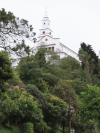








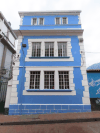









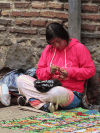


From the Gold Museum, Bogotá entry in Wikipedia:
The Museum of Gold (Spanish: El Museo del Oro) is a museum located in Bogotá, Colombia. It is one of the most visited touristic highlights in the country. The museum receives around 500,000 tourists per year.
The museum displays a selection of pre-Columbian gold and other metal alloys, such as Tumbaga, and contains the largest collection of gold artifacts in the world in its exhibition rooms on the second and third floors. Together with pottery, stone, shell, wood and textile objects, these items, made of a – to indigenous cultures – sacred metal, testify to the life and thought of the different societies which lived in present-day Colombia before the Spanish conquest of the Americas.
In 1934, the Bank of the Republic began helping to protect the archaeological patrimony of Colombia. The object known as Poporo Quimbaya was the first one in a collection. It has been on exhibition for 70 years. The Museum is today administered by Banrepcultural.
The museum houses the famous Muisca golden raft found in Pasca in 1969, that represents the ceremony of the new zipa (ruler) of Bacatá, the basis for the El Dorado myth. The heir to the chieftaincy assumed power with a great offering to the gods. In this representation he is seen standing at the center of a raft, surrounded by the principal chieftains, all of them adorned with gold and feathers.
The museum has a collection of 55,000 pieces, 6,000 of which are on display in their expanded building. There are bilingual descriptions of almost all exhibits. On the first floor houses the museum's main entrance, a shop, and a restaurant.
Exhibitions begin on the second floor. The main room is called "People and Gold in pre-Hispanic Colombia". In glass vitrines display goldsmiths' work from the different cultures which inhabited Colombia before the Spanish colonists arrived. The permanent exhibition is divided into different halls for every culture: Calima, Quimbaya, Muisca, Zenú, Tierradentro, San Agustín, Tolima, Tairona, and Urabá, and a special room called "After Columbus" (Después de Colón).
The exposition continues on the third floor, with "The Flying Chamanic" and "The Offering." The first shows the process of a shamanic ceremony with its different gold pieces, the second is divided into three parts: the "Offering Room", the "Offering Boat", and the "Lake".
At the end of the exposition, there is a "Profunditation Room" with artistic videos about the most important gold pieces of the museum.

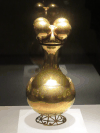





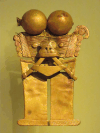




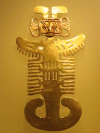




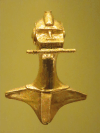
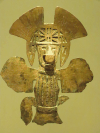





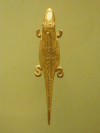


















This page contains 75 pictures
Page last updated on Tue Nov 2 15:34:52 2021 (Mountain Standard Time)
Bogotá on guenther-eichhorn.com